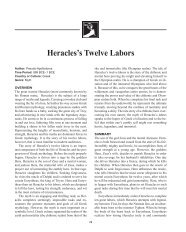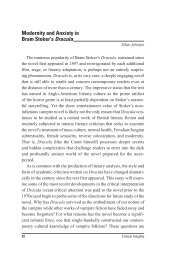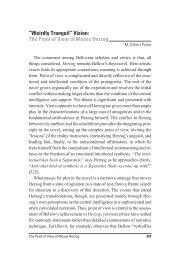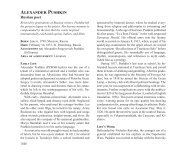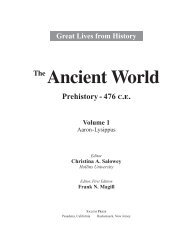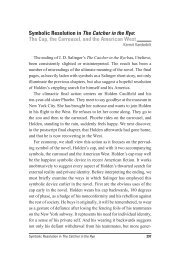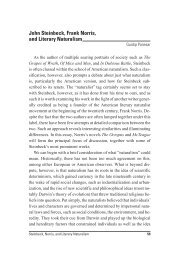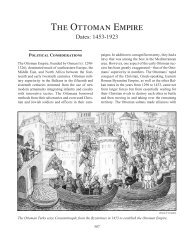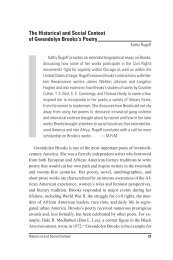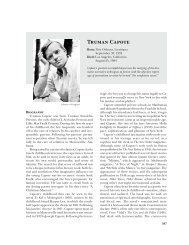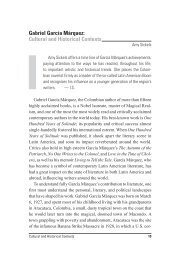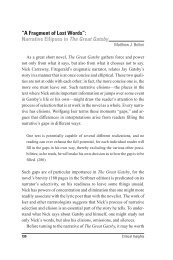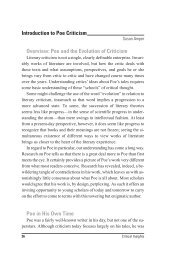You also want an ePaper? Increase the reach of your titles
YUMPU automatically turns print PDFs into web optimized ePapers that Google loves.
Critical Survey of Poetry <strong>Nash</strong>e, Thomas<br />
the longer work: man’s weakness in face of natural elements.<br />
The refrain, repeated at the end of each of the two<br />
stanzas, is “From winter, plague, & pestilence, good<br />
Lord, deliver us.”<br />
It was surely fear of the plague and of man’s frailty in<br />
general that led <strong>Nash</strong>e to write the best of his lyrics,<br />
“Song: Adieu, farewell earths blisse,” sung to the dying<br />
Summer by Will Summer. <strong>Nash</strong>e recognizes in the<br />
refrain which follows each of the six stanzas that he<br />
is sick, he must die, and he prays: “Lord, have mercy<br />
on us.”<br />
In a logical development, <strong>Nash</strong>e first introduces<br />
the theme of Everyman: “Fond are lifes lustful ioyes.”<br />
In succeeding stanzas he develops each of the “lustfull<br />
ioyes” in turn. “Rich men” are warned not to trust in<br />
their wealth, “Beauty” is revealed as transitory,<br />
“Strength” is pictured surrendering to the grave, and<br />
“Wit” is useless to dissuade Hell’s executioner. In a very<br />
specific, orderly manner and in spare iambic trimeter<br />
lines, <strong>Nash</strong>e presents man’s death-lament and prayer for<br />
mercy. One stanza will show the strength of the whole<br />
poem:<br />
Beauty is but a flowre,<br />
Which wrinckles will deuoure,<br />
Brightnesse falls from the ayre,<br />
Queenes have died yong and faire,<br />
Dust hath closed Helens eye.<br />
I am sick, I must dye:<br />
Lord, have mercy on vs.<br />
The Choise of Valentines<br />
<strong>Nash</strong>e’s last poem is by far his longest. The Choise of<br />
Valentines is an erotic narrative poem in heroic couplets<br />
running to more than three hundred lines. With the kind<br />
of specificity that one would expect from the author of<br />
The Unfortunate Traveller, <strong>Nash</strong>e tells of the visit of the<br />
young man Tomalin to a brothel in search of his valentine,<br />
“gentle mistris Francis.” Tomalin’s detailed exploration<br />
of the woman’s anatomical charms, his unexpected<br />
loss of sexual potency, and her announced<br />
preference for a dildo all combine to present an Ovidian<br />
erotic-mythological poem of the type popular in Elizabethan<br />
England. <strong>Nash</strong>e’s poem must, however, be set off<br />
from Shakespeare’s Venus and Adonis (1593) and<br />
Marlowe’s Hero and Leander (1598), which emphasize<br />
the mythological more than the erotic. <strong>Nash</strong>e clearly<br />
emphasizes the erotic, almost to the exclusion of the<br />
mythological. Why not? he seems to say in the dedicatory<br />
sonnet accompanying the poem: Ovid was his<br />
guide, and “Ouids wanton Muse did not offend.”<br />
Nowhere, with the exception of the excellent “Song:<br />
Adieu, farewell earths blisse,” does <strong>Nash</strong>e rise to the<br />
heights of his greatest contemporaries, Spenser, Sidney,<br />
Marlowe, and Shakespeare. In that poem, in the sonnet<br />
“Were there no warres,” and in perhaps one or two other<br />
poems his Muse is sufficiently shaken into consciousness<br />
by the poet’s interest in the subject. The remainder<br />
of <strong>Nash</strong>e’s poetry is the work of an excellent craftsman<br />
who is playing with form and language.<br />
Other major works<br />
long fiction: The Unfortunate Traveller: Or,<br />
The Life of Jack Wilton, 1594 (prose and poetry).<br />
plays: Dido, Queen of Carthage, pr. c. 1586-1587<br />
(with Christopher Marlowe); Summer’s Last Will and<br />
Testament, pr. 1592; The Isle of Dogs, pr. 1597 (with<br />
Ben Jonson; no longer extant).<br />
nonfiction: preface to Robert Greene’s Menaphon,<br />
1589; The Anatomie of Absurditie, 1589; An<br />
Almond for a Parrat, 1590; preface to Sir Philip Sidney’s<br />
Astrophel and Stella, 1591; Pierce Peniless,<br />
His Supplication to the Divell, 1592 (prose and poetry);<br />
preface to Greene’s A Quip for an Upstart<br />
Courtier, 1592; Strange News of the Intercepting of<br />
Certain Letters, 1592 (prose and poetry; also known<br />
as The Four Letters Confuted); Christ’s Tears over<br />
Jerusalem, 1593; The Terrors of the Night, 1594;<br />
Have with You to Saffron-Walden, 1596; <strong>Nash</strong>e’s<br />
Lenten Stuffe, 1599.<br />
Bibliography<br />
Helgerson, Richard. The Elizabethan Prodigals. Berkeley:<br />
University of California <strong>Press</strong>, 1977. <strong>Nash</strong>e and<br />
his colleagues Christopher Marlowe, Thomas Kyd,<br />
George Peele, Robert Greene, and Thomas Lodge,<br />
all with university training, formed a group of literary<br />
bohemians in London. Helgerson catalogs their<br />
escapades and relates them to their lives, which were<br />
adventurous, barbarous, and impoverished in turn.<br />
The index cross-references topics well.<br />
2743



